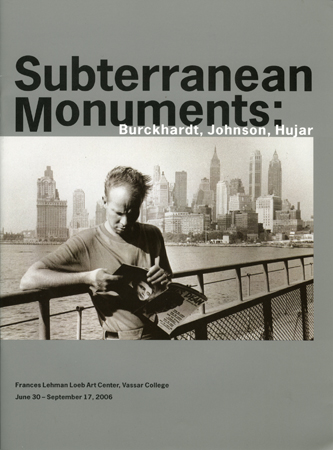

home | books | poetry | plays | translations | online | criticism | video | collaboration | press | calendar | bio
| Art Books and Catalogues | Curatorial | Poetry | Translation |
 |
|||
| Subterranean Monuments: Burckhardt, Johnson, Hujar, 2006, Frances Lehman Loeb Art Center, Vassar College, Poughkeepsie | |||
|
Rudy Burckhardt: Inside Outsider Rudy Burckhardt was an inveterate outsider and the ultimate insider. It is useful to consider him with Peter Hujar and Ray Johnson, as the same can be said of them. Working outside of received channels was natural to all three, as was collaboration, which dimmed the presence of ego’s claims. Much of Burckhardt’s impulse can be read in terms of his flight from stifling convention in upper-class Basel. He determined, at an early age, that even Paris and London in the 1930s were not cosmopolitan enough and soon found himself allied with dancer, poet and critic Edwin Denby, in New York City. Willem de Kooning was their neighbor, and Denby introduced Burckhardt to other top-flight intellectuals. Within a year after arriving in New York in 1935, Burckhardt made a short 16-mm film, featuring Aaron Copland, Virgil Thomson, and Paul Bowles. One avenue to thinking about Burckhardt could be the writing of Edwin Denby—not so much his sonnets, though their Mediterranean Cities, a book of poems and photographs, remains for me one of the apexes of literary collaboration, but rather Denby’s dance criticism, much of which he wrote right after a performance for publication in the next day’s newspaper. That performative act alone is inspirational, particularly when executed at such a high level of style and technique. In particular, one can see in Denby’s criticism brilliant combinations of the specific and the general, the erudite and the eminently accessible, all qualities one might apply as well to Rudy Burckhardt’s photographs. One should keep in mind, though, that Burckhardt’s aesthetic developed early. Even before he met Denby, while still in Europe, he took photographs that are surprising in their simultaneous clarity and informality. In New York, Burckhardt found his ultimate setting, and his trips to Haiti, Naples, and Morocco, for all the empathy and understanding they show of their subjects, can be seen as post-New York, in the sense that it was in New York that Burckhardt learned to see, and to be free. Finally free from the social constraints that weighed so heavily on him in Europe, he could now mingle with the crowd, be accepted as an anonymous part of it. He could observe and take in the skyscraper’s sense of scale. Another comparison could be made to Merce Cunningham’s choreography of the 1950s, in some of which he wanted his dancers to interact much as pedestrians would on a New York sidewalk at rush hour, just conscious enough of each other to avoid collision. Burckhardt recorded similar interactions with his camera, but we should note that he began his studies in the late 1930s, when he was in his early 20s. These close-up views of crowds or storefronts, some of them radically cropped to reveal only the hems and cuffs and footwear of midtown walkers, were unique at a time when photography usually opted either for the formal or the social. Burckhardt’s photos were neither, and they remained so. They are exquisitely composed pictures, beyond the reach of Cartier-Bresson in terms of depth of plane, yet they come about their pleasures casually. They reveal rich layers of social interaction in a daunting variety of locales and show things as they are on an average day. There is never a hint of preaching; Burckhardt was likely to depict someone who could be considered part of an underclass not as suffering but as supremely beautiful. Burckhardt’s photography changed over the years. In the 1960s, he devoted much of his energy to filmmaking; when he re-devoted his full energy to photography, in the 1970s, his informalism took on more panache. His young couples on the street or in the subway could often be out of focus, their blurs lightly suggesting the speed of their walking, but also indicating Burckhardt’s fearlessness in the face of the belief that focus is the same thing as quality. One often finds in artists a growing freedom with age; they discover that they have the ability to convey more with a rapid brushstroke or photographic composition than they once could with carefully rendered details. In Burckhardt’s photographs of the 1970s to 1990s, I find parallels to work of photographers much younger than he. The informal styles of photographers such as Nan Goldin, Jack Pierson, and Wolfgang Tillmans were presaged by work by Rudy Burckhardt, though they may not have known it. These younger artists share with Burckhardt a romance with the big city and a fascination with casual sexuality. These photographers are rightly recognized as innovative for having moved away from the strictures set down for modern photography. Burckhardt, too, was never comfortable with those strictures; his life and work show his devotion to living apart from them. |
|||